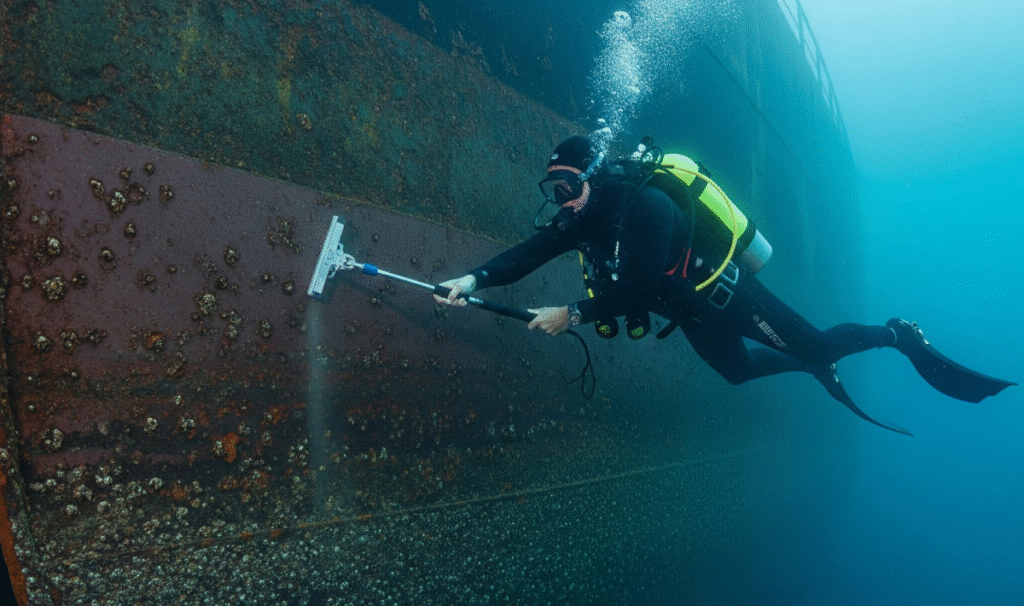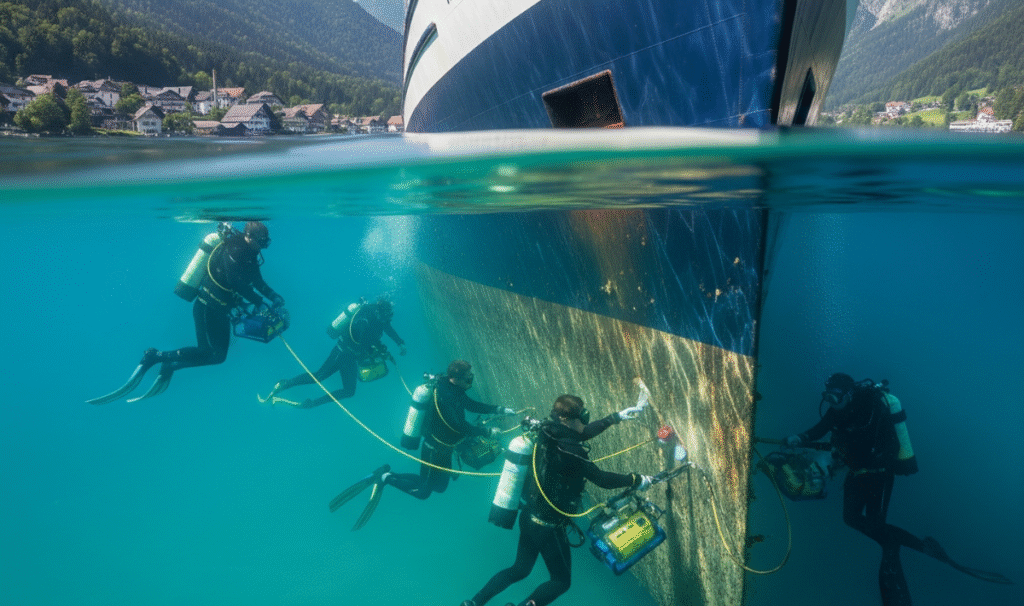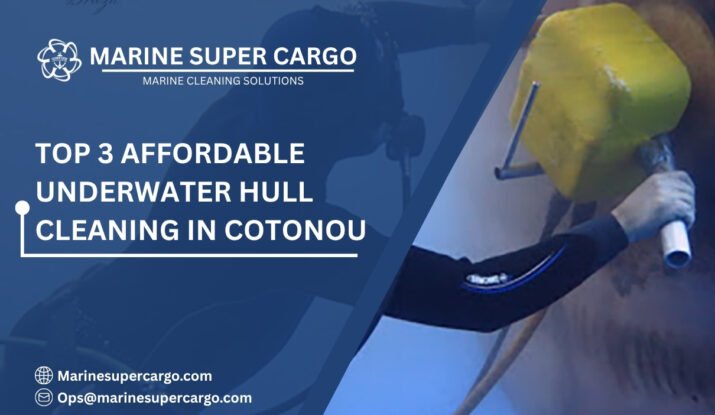Picture your vessel as a high-performance sports car. Now imagine that same car covered in mud, with the engine working twice as hard just to reach the same speed. That’s exactly what happens when biofouling builds up on your ship’s hull. It may look minor on the surface, but beneath the waterline, it’s costing you fuel, money, and reputation.
This is why underwater hull cleaning in Cotonou has become such a vital part of ship management. More than just scrubbing off barnacles, it’s about compliance, sustainability, fuel savings, and future-proofing your operations in one of West Africa’s most strategic ports.
Why Hull Cleaning is Essential for Modern Shipping
Every ship owner knows that operating costs are tight, and margins even tighter. Hull fouling may seem like an inconvenient maintenance task, but left unchecked, it creates a ripple effect:
- Fuel consumption shoots up due to increased drag.
- Emissions rise, putting your ship at odds with the IMO’s decarbonization targets.
- Biofouling can transport invasive species into fragile ecosystems.
Regular underwater hull cleaning in Cotonou does more than polish your ship’s appearance—it ensures your vessel is compliant, efficient, and future-ready.
Cotonou’s Growing Role in Global Trade
Cotonou, the economic powerhouse of Benin, handles nearly 90% of the country’s international trade. As the “Gateway to West Africa,” the Port of Cotonou serves as a regional hub for container shipping, bulk cargo, and oil tankers.
- Shallow access channels make vessel performance key.
- Warm tropical waters accelerate marine growth.
- High frequencies of turnarounds demand that ships maintain peak operability.
All of these factors make underwater hull cleaning in Cotonou not just beneficial, but necessary for ships competing in the region.

The Process Explained: How Hull Cleaning Works
Think of hull cleaning as a spa treatment for your vessel, but with strict technical precision. The process involves several steps:
Step 1: Pre-Clean Inspection
Divers or remotely operated vehicles (ROVs) assess the hull’s condition and identify high-fouling areas.
Step 2: Setup and Safety Measures
Permits, safety checks, and environmental safeguards are confirmed before work starts, following guidelines from IMCA and IMO.
Step 3: Mechanical Cleaning
Divers use hydraulic brushes, scrapers, and rotary tools to remove fouling without damaging anti-fouling coatings.
Step 4: Polishing and Performance Testing
Light polishing reduces surface roughness, improving hydrodynamic efficiency.
Step 5: Post-Clean Documentation
Inspection reports, photos, and compliance records are created for ship managers and authorities. This is where underwater hull cleaning in Cotonou sets itself apart: regulations may differ slightly from larger seaports, but the fundamentals stay consistent with IMO-approved practices.
Environmental and Regulatory Considerations
Cleaning a hull isn’t just about removing slime and barnacles. Done wrong, it can release toxic paint particles, invasive organisms, and harmful waste into the water.
According to the Marine Pollution (MARPOL) Convention and IMO biofouling guidelines:
- Waste must be contained, not discharged into the sea.
- Capture-and-recovery systems are encouraged for responsible cleaning.
- Records of cleaning activities help demonstrate environmental stewardship.
Ship owners who neglect compliance risk fines, detentions, or even entry bans. In today’s world, underwater hull cleaning in Cotonou is inseparable from environmental responsibility.
Related Resource: Underwater Ship Hull Cleaning in China – A detailed look at national practices complementing Shenzhen’s local expertise.
Cost-Saving Advantages
Let’s put it into numbers. Fuel consumption accounts for up to 70% of operational costs. Even a small increase in drag from fouling can sink your budget.
- A fouled hull may raise fuel usage by 10–20%.
- That translates into tens of thousands of dollars lost per voyage.
- Regular cleaning extends coating lifespan, delaying costly drydock visits.
Instead of treating hull cleaning as just another bill, view underwater hull cleaning in Cotonou as an investment. Like changing the oil in a car, it’s routine care that keeps you from facing a much bigger expense later.
Sustainability Matters: Cleaner Waters, Greener Vessels
The global shipping industry is under pressure to curb emissions and adopt sustainable practices. Hull cleaning plays an underrated role in this effort.
- Lower drag = less fuel = fewer CO₂ emissions.
- Controlled cleaning prevents invasive species transfer between ecosystems.
- Modern cleaning tech emphasizes eco-friendly practices aligned with IAPH (International Association of Ports & Harbors) sustainability initiatives.
When you choose underwater hull cleaning in Cotonou, you’re not only improving your ship—you’re contributing to greener global trade.
Challenges of Hull Cleaning in Cotonou
While the benefits are clear, Cotonou does present unique challenges:
- Tropical waters mean fouling grows more aggressively.
- Port congestion requires scheduling maintenance without disrupting cargo operations.
- Local regulations may differ slightly from other regions, requiring managers to stay updated.
- Visibility conditions underwater can be poor, complicating diver operations.
Despite these hurdles, ship operators balance risk against reward, and the clear advantages of underwater hull cleaning in Cotonou make the effort worthwhile.
Modern Innovations in Hull Cleaning
From old-fashioned brushes to futuristic, eco-friendly robotics, hull cleaning has come a long way. Modern practices are shaping the future of fleet maintenance.
- ROVs (Remotely Operated Vehicles) reduce diver risk and can capture debris.
- Hull-cleaning robots powered by AI optimize efficiency and track cleaning data.
- Self-polishing coatings make it harder for organisms to stick, reducing the need for frequent interventions.
- Data-driven maintenance enables predictive scheduling, so cleaning is done before fouling impacts performance.
Expect to see underwater hull cleaning in Cotonou become increasingly technology-driven over the next decade.
Best Practices for Ship Owners and Managers
If you’re navigating maintenance decisions, here’s how to make the most of hull cleaning in Cotonou:
- Schedule inspections at least every 3–6 months.
- Hire contractors certified by IMCA and recognized by local port authorities.
- Use eco-friendly methods that comply with IMO guidelines.
- Coord cleaning with berthing time to avoid operational delays.
- Document activities as part of your Safety Management Systems (SMS).
Adopting these best practices ensures safety, compliance, and maximum ROI from underwater hull cleaning in Cotonou.

The Future of Hull Cleaning in Cotonou
Looking forward, hull cleaning will continue to evolve along three major lines:
- Technology integration: ROVs, robotics, and real-time data solutions will replace manual-intensive tasks.
- Stricter compliance: Regulations from IMO and MARPOL will be more strictly enforced worldwide.
- Sustainability goals: Cleaner hulls will be directly tied to decarbonization targets for international shipping.
For Cotonou, this means ships operating in the region will increasingly need to adopt advanced, environmentally responsible cleaning strategies to remain competitive.
Read also: Underwater hull cleaning in Albania and how national policies align with Durrës’ local efforts.
Conclusion
The performance of your vessel starts below the waterline. A fouled hull is like dragging an anchor behind you—slow, costly, and unsustainable. By investing in underwater hull cleaning in Cotonou, ship owners can cut operating costs, meet international compliance standards, and safeguard aquatic ecosystems.
As global trade expands and sustainability pressures rise, proactive hull cleaning is no longer optional—it’s essential. In Cotonou, a port that’s becoming a major West African hub, partnering with experts like CleanShip.co ensures your hull remains clean, your fleet competitive, and your operations sustainable.
FAQ:
Q1. How often should underwater hull cleaning in Cotonou be scheduled?
Most vessels benefit from inspections every 3–6 months, depending on coating type and trading patterns.
Q2. Does underwater hull cleaning in Cotonou disrupt cargo operations?
Not necessarily. With proper planning, cleaning can be scheduled during cargo handling or idle time.
Q3. How much fuel savings can I expect after hull cleaning?
Savings usually range from 5–20%, depending on the fouling severity.
Q4. Is underwater hull cleaning in Cotonou environmentally compliant?
Yes, when done with IMO-approved techniques and debris capture systems.
Q5. Will robotics fully replace divers in hull cleaning?
Not yet, but adoption of ROVs and automated systems is growing rapidly, especially in heavily regulated ports.


